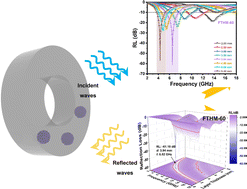Flower-like 1T/2H-MoS2@α-Fe2O3 with enhanced electromagnetic wave absorption capabilities in the low frequency range
Abstract
In this work, we designed the flower-like structure of 1T/2H-MoS2@α-Fe2O3 nanocomposites with high-efficiency microwave absorption, in which the α-Fe2O3 microdrums are attached to the surface of 1T/2H-MoS2 constituting a special flower-like morphology. During the synthesis process, the content of α-Fe2O3 microdrums plays a significant, constructive role in the dielectric properties and impedance matching characteristics of the 1T/2H-MoS2@α-Fe2O3 nanocomposites. The optimal reflection loss (RL) value of the flower-like nanocomposites can reach −61.18 dB at low frequency (6.52 GHz), while the RL value is also −56.98 dB at 4.43 GHz with a lower frequency. Furthermore, the frequency bandwidth below −10 dB was up to 4.68 GHz with an effective absorption frequency range of 13.32–18 GHz when the thickness was 1.82 mm. The results show that excellent electromagnetic wave absorption capabilities of the 1T/2H-MoS2@α-Fe2O3 nanocomposites in the low frequency range mainly benefit from the perfect coordination of multiphase MoS2 and α-Fe2O3 microdrums, which makes them achieve perfect impedance matching in the low frequency range. This provides a simple demonstration for the development of highly efficient electromagnetic wave absorption materials in the low frequency range.



 Please wait while we load your content...
Please wait while we load your content...